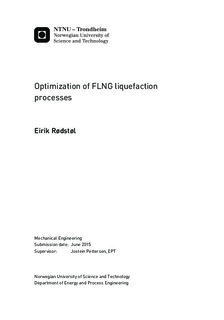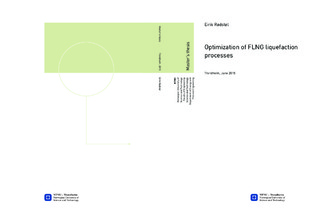| dc.description.abstract | As the development of FLNG is on the rise, improvements in liquefaction process design and operation is of high priority. The liquefaction processes utilized for FLNG vary in complexity and efficiency. Space requirement and efficiency are high priorities for FLNG and mixed refrigerant processes such as Prico and DMR are suitable processes. In order to improve the liquefaction processes in terms of energy use, many factors needs to be considered and the task can be challenging. A specialization project carried out in the fall of 2014 (Rødstøl 2014) concluded that amongst the built-in optimizers in Hysys, the Hyprotech SQP optimizer is the most suitable optimizer when dealing with advanced liquefaction processes. The purpose of this thesis is to explore the Hyprotech SQP optimizer in terms of its applicability to mixed refrigerant liquefaction processes and challenges it may come across.
Prico and DMR liquefaction processes were modelled and described as a base for several case studies that were carried out in order to challenge the optimizer. The optimizer was challenged in regards to process design, process modifications, initial variable values, variable boundaries and constraints. Studies in relation to the different optimizer parameters were carried out in both models with setup recommendations for the parameters. The Prico process was modified in regards to process temperatures, pressure levels, initial variable values, initial variable boundaries and process constraints. The DMR process was modified in regards to three different constraint conditions in the Warm Mixed Refrigerant (WMR) circuit that was used to investigate whether the optimizer provided logical decisions to uphold the given constraints. Additionally, the DMR process was optimized in regards to different pressure levels, process constraints and process temperatures.
The final case study was carried out in order to improve an earlier optimized DMR process in regards of energy usage. As the study progressed, more and more constraints were put on the process to make the optimization more challenging.
The studies in the modelled Prico and DMR process showed that the optimizer was able to adapt to process modifications by small adjustments in either the Flowsheet, derivative utility or the optimizer parameters, which were carried out in terms of analyses. As different process modifications were carried out, the optimizer provided logical decisions in regards to the refrigerant composition and pressure levels.
In the final study, the optimizer improved an earlier optimized DMR process provided by Kusmaya (2012). The improvements were carried out with the process being constrained further as the study progressed. The Hyprotech SQP optimizer was able to reduce the energy consumption by 17%, and by utilizing same compressor drivers as Kusmaya (2012); the optimizer was able to provide a model that had 17% higher LNG production.
Results from the studies show that the Hyprotech SQP optimizer may be challenging to adjust, and simplifications in the Flowsheet may be carried out in order to assist the optimizer. By adjusting the derivative and the optimizer parameters, the Hyprotech SQP optimizer is able to provide good objective values that upholds the given constraints. | |

